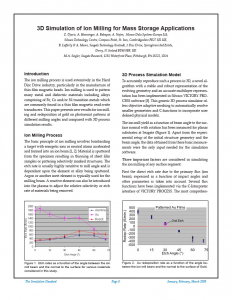3D Simulation of Ion Milling for Mass Storage Applications
Z. Djuric, A. Hoessinger, A. Babayan, A. Nejim, Silvaco Data Systems Europe Ltd,
Silvaco Technology Centre, Compass Point, St. Ives, Cambridgeshire PE27 5JL UK,
B. Lafferty & A. Moore, Seagate Technology (Ireland), 1 Disc Drive, Springtown Ind Estate,
Derry, N. Ireland BT48 0BF, UK
M.A. Seigler, Seagate Research, 1251 Waterfront Place, Pittsburgh, PA 15222, USA
Introduction
The ion milling process is used extensively in the Hard Disc Drive industry, particularly in the manufacture of thin film magnetic heads. Ion milling is used to pattern many metal and dielectric materials including alloys comprising of Fe, Co and/or Ni transition metals which are commonly found in a thin film magnetic read-write transducers. This paper presents new results for ion milling and redeposition of gold on photoresist patterns at different milling angles and compared with 3D process simulation results.
Ion Milling Process
The basic principle of ion milling involves bombarding a target with energetic ions or neutral atoms accelerated and formed into an ion beam [1, 2]. Material is sputtered from the specimen resulting in thinning of sheet film samples or pattering selectively masked structures. The etch rate is usually highly sensitive to mill angle and is dependant upon the element or alloy being sputtered. Argon or another inert element is typically used for the milling beam. A reactive element can also be introduced into the plasma to adjust the relative selectivity or etch rate of materials being removed.



